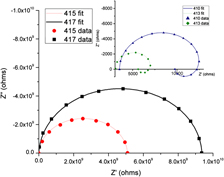Crossref Citations
This article has been cited by the following publications. This list is generated based on data provided by
Crossref.
Muhlbauer, Rachel L.
and
Gerhardt, Rosario A.
2013.
Determining In-plane and Thru-plane Percolation Thresholds for Carbon Nanotube Thin Films Deposited on Paper Substrates Using Impedance Spectroscopy.
MRS Proceedings,
Vol. 1549,
Issue. ,
p.
117.
Muhlbauer, Rachel L.
Pruyn, Timothy L.
Puckett, Waylon T.
and
Gerhardt, Rosario A.
2014.
Effect of graphitic filler size and shape on the microstructure, electrical percolation behavior and thermal properties of nanostructured multilayered carbon films deposited onto paper substrates.
Journal of Materials Research,
Vol. 29,
Issue. 3,
p.
472.
Muhlbauer, Rachel L.
Gussenhoven, Ryan J.
and
Gerhardt, Rosario A.
2014.
Advances in Materials Science for Environmental and Energy Technologies III.
Vol. 250,
Issue. ,
p.
299.
Yue, S.X.
Su, Y.C.
Luo, Z.B.
Yu, Q.S.
Tursun, R.
and
Zhang, J.
2019.
Influence of surfactant interaction on ultrafine copper powder electrodeposition.
Materialwissenschaft und Werkstofftechnik,
Vol. 50,
Issue. 7,
p.
856.
Joshi, Salil M.
Xia, Ning
Berta, Yolande
Ding, Yong
Gerhardt, Rosario A.
Littrell, Kenneth C.
Woods, Eric
and
Tian, Mengkun
2020.
Detection of plasmonic behavior in colloidal indium tin oxide films by impedance spectroscopy.
MRS Communications,
Vol. 10,
Issue. 2,
p.
278.
Muhlbauer, Rachel L.
and
Gerhardt, Rosario A.
2021.
Impedance spectroscopy of short multiwalled carbon nanotube networks deposited on a paper substrate: tracking the evolution of in-plane and thru-plane electronic properties.
Journal of Materials Science,
Vol. 56,
Issue. 4,
p.
3256.
Jiang, Kyle
and
Gerhardt, Rosario A.
2021.
Fabrication and Supercapacitor Applications of Multiwall Carbon Nanotube Thin Films.
C,
Vol. 7,
Issue. 4,
p.
70.
Jin, Yifan
and
Gerhardt, Rosario A.
2023.
Simplified Simulations and Experiments to Determine Impedance Trends for Parallel Circuits in Series and in Parallel.
p.
698.
Mun, Hyung Jin
Park, Ji Young
Lim, Minseob
Cho, Hong‐Baek
and
Choa, Yong‐Ho
2023.
Preparation of h‐BN microspheres for nanocomposites with high through‐plane thermal conductivity.
Journal of the American Ceramic Society,
Vol. 106,
Issue. 12,
p.
7240.
Ka, Dongwon
Jeong, Keunhong
and
Jin, Youngho
2023.
Reduced graphene oxide coated cotton e-textile for wearable chemical warfare agent sensors.
Advanced Composite Materials,
Vol. 32,
Issue. 5,
p.
647.
Gerhardt, Rosario A.
2024.
Encyclopedia of Condensed Matter Physics.
p.
266.
